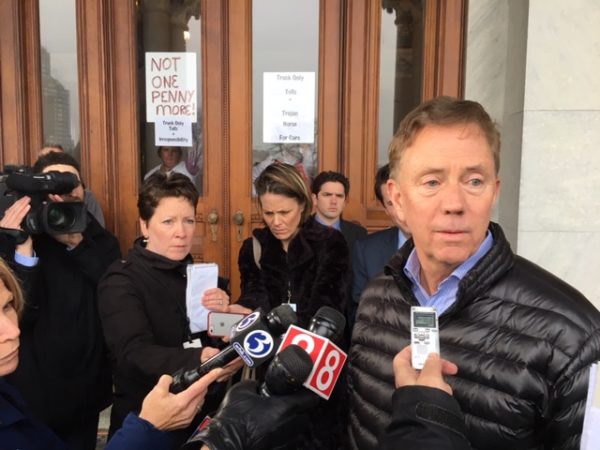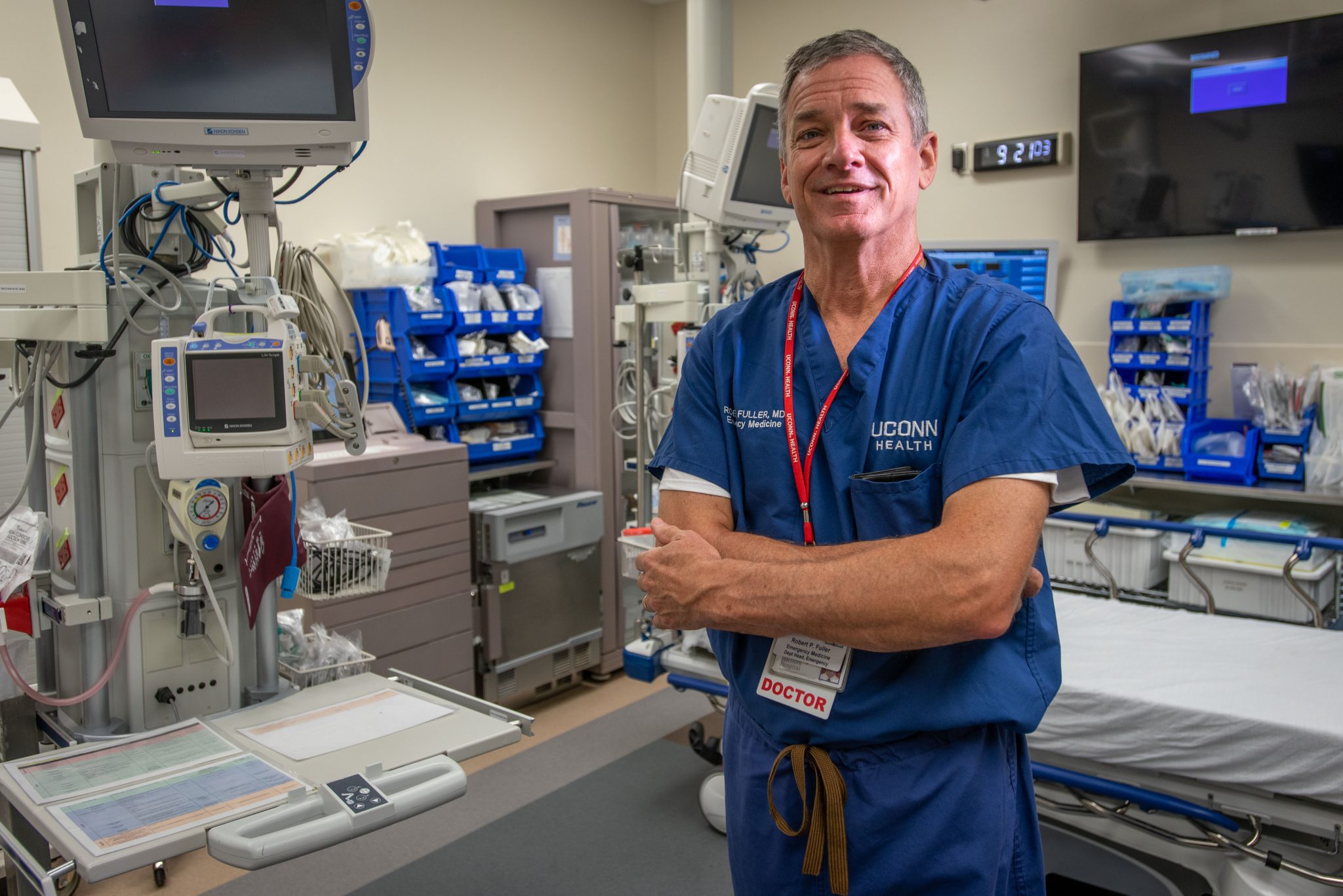Lamont Looks for Big Finish to Close his First Year

Audio By Carbonatix

Legislators are aiming to vote on a transportation package, and other items, in special session in January.
By Mark Pazniokas, CTMirror.org
The political strengths and weaknesses constant to Gov. Ned Lamont’s first year in office were on full display as he addressed municipal officials last week. He was cheerful, optimistic, self-deprecating and, ultimately, not entirely reassuring.
Lamont owes them money – quite a lot, in fact. Town aid for roads and local capital improvements is being withheld while the governor tries to close on an elusive deal with lawmakers over how to finance billions in transportation infrastructure improvements over the next decade.
“I think we’re pretty close on an agreement,” Lamont told the local officials. “I hope we’re very close. I think I’ve said that before. One of the things I’m finding in government, that was not my life in business, is in government you can agree up to the two yard line. It’s getting that final two yards that is an awful lot of effort.”
It is in those moments that Connecticut’s rookie governor sounds less like a politician than a bemused observer of politics, a stranger seeking his way in a strange land.
“I keep reading all these articles about, ‘When is he going to learn the ways of the legislature?’” Lamont said Monday. “Well, we’re both going to work together. Or we’re both going to learn, because I was elected to do things in a different way.”
Perhaps they have.
For the first time since Lamont took office on Jan. 9, the Democratic governor and the leaders of the Democratic majorities in the General Assembly are working in concert on the passage of a transportation financing plan, one that would rely on truck-only tolls.
It is an undertaking that has bedeviled Lamont and overshadowed first-year successes that include the passage of a budget without raising the income tax or tapping budget reserves, as well as delivering on campaign promises to raise the minimum wage and create a paid family and medical leave program.
But his job-approval ratings cratered as his first-year agenda was dominated by his pursuit of new transportation revenue, beginning with an ill-fated plan to raise $800 million a year by charging tolls on all motor vehicles at more than 50 locations.
Profanely, he dismissed the cost to his popularity.
“I can’t care about that shit. If I do, then I’m just going to pull my punches, right?” Lamont said. “Let’s just not do transportation? I would have had a great year, a great year. But I wouldn’t have solved a big problem that’s confronting us.”
The governor spoke during an interview in his office Monday, a day when his duties included a press conference in the rain with a 900-pound cow named Leia as part of a promotional event marking the 50th anniversary of Stew Leonard’s, the Norwalk-based supermarket chain that calls itself the “Disneyland of Dairy Stores.”
On the north steps of the Capitol, Lamont offered a milk toast to Stew Leonard, the 91-year-old founder, and Stew Leonard Jr., the current chief executive. Behind them, anti-toll protesters conducted a silent vigil.
Lamont’s latest transportation plan would raise $187 million annually in tolls on trucks, enough to finance $19.4 billion in transportation infrastructure improvements over 10 years, according to financials released Friday.
Legislative leaders are aiming for a vote during a special session in January – one of two special sessions expected before the annual 2020 session opens in February.
Next week, Lamont intends to ask legislators to accept a $1.8 billion settlement his administration has negotiated with the state’s hospital industry, resolving a war over taxes begun by his predecessor, Dannel P. Malloy.
“That was an incredible black cloud hanging over the state,” Lamont said. “We had a potential $4 billion judgment against us. You know what that would have meant? That was about $400 million a year paid by the taxpayers over the course of 20 years.”
If successful on both undertakings, Lamont will have swept a glossy finish over a rocky first year.
Lamont, 65, is a cable-television entrepreneur from Greenwich, the husband of a successful venture capitalist and a friend to successful men and women in the worlds of technology, finance, and corporate governance. He has tried to bring elements of his old world into his new one.
“One of the things I’ve really worked hard to do is get that piece of the state more involved in Hartford and not New York,” Lamont said.
His chief of staff, Ryan Drajewicz, was hired from Bridgewater Associates, the giant hedge fund founded by the billionaire and philantropist, Ray Dalio. His economic adviser, David Lehman, came from Goldman Sachs. Lamont hired a tech entrepreneur, Josh Geballe, as the commissioner of administrative services.
On a few occasions since taking office 11 months ago, Lamont said, he has mixed what he called the “Hartford crowd” and the “Fairfield County crowd” at dinners at his home in Greenwich.
“I just sit back and sort of watch the tensions,” Lamont said. “It’s sort of fascinating. We are two states.”
Those tensions are evident at times in his own administration.
Lamont badly misread how the public and lawmakers would respond to his proposal in February to raise as much as $800 million annually by installing more than 50 electronic tolling gantries on Route 15 and Interstates 84, 91, and 95.
In doing so, the governor reneged on a campaign promise to seek only tolls on trucks as recently implemented in Rhode Island. And he broke the news by a publishing an op-ed piece on President’s Day Weekend.
“Was I a little taken by surprise?” Lamont said of the backlash. “Yeah, because I had every business leader say, ‘It’s really important – transportation, rail, and road – or else I may not be here in five years.’ ”
His plan never came to a vote.
The administration developed a new plan, CT2030, that offered a new funding mechanism: low-cost federal loans that would be paid off by $320 million collected annually from tolls on 14 bridges.
The plan won bipartisan praise for identifying projects that could improve commutes by improving Metro-North commuter rail and eliminating highway chokepoints. But, again, the administration misread the depth of opposition to tolls on passenger cars.
Less than a week after its release, Republicans said they could not support tolls or any other new revenue and Senate Democrats took automobile tolls off the table, saying the administration had to find something that was politically “palatable.”
“It was the right plan. Everybody said it was the right plan,” Lamont said. “They just didn’t want to pay for it.”
Lamont said he had no regrets, nor did he ever seriously contemplate abandoning the search for a way to stabilize a Special Transportation Fund expected to hit insolvency in five years. Financed by fuel taxes and fees, the fund pays for the operating expenses of the Transportation and Motor Vehicle departments and the debt service on transportation projects.
“I’m asking people to do something pretty tough,” Lamont said. “So, do I regret coming out with 2030 because I got my head handed to me in a couple of caucuses? No.”
Lamont said he is trying to show Connecticut employers what the state could look like in 10 years.
“I didn’t really have much of a choice if I’m going to solve this problem. And I’m going to make these guys solve it,” Lamont said of legislators. “I mean, that’s the deal. I’ll meet you half way, and we’ll negotiate, but this is a state, year in and year out and decade in and decade out, that hopes the roof doesn’t fall on their head. And this is not the way I do it.”
Lamont has both benefitted and suffered by comparisons with Malloy, a former Stamford mayor who took office with a sharply defined agenda, a command of details, a coterie of experienced political aides and a talent for twisting arms.
The new governor has a gentler, more personal touch.
Joe DeLong, the president of the Connecticut Conference of Municipalities, said municipal leaders were more forgiving of Lamont for holding back town road aid than they would have been a year earlier with Malloy.
“I think that’s a tribute to him,” DeLong said. “If this had been toward the end of the prior administration and we were waiting on this money, we probably would be holding press conferences and throwing grenades by now.”
DeLong and Waterbury Mayor Neil O’Leary, who recently ended a term as president of CCM, both said Lamont called regularly with updates on his talks with lawmakers, assuring them that their aid eventually would be forthcoming.
“I’m happy with what he did with municipalities in the budget. At least it was stable, which is what we were asking for,” said Mayor Laura Hoydick of Stratford, a Republican and former state representative. “I think those were all positive things, and I think he really is pro-Connecticut, and he vocalizes it. He is Connecticut’s best cheerleader. And it’s really important for a leader to do that.”
His reviews in the Capitol are more measured, with two leaders differing on what the governor learned from his first-year difficulties.
“I think the governor is learning and developing as he goes along,” said Senate President Martin M. Looney, D-New Haven. “I think that’s a strong positive. He is a bright and thoughtful man, and his experience will benefit him.”
Senate Minority Leader Len Fasano, R-North Haven, said he appreciates that Lamont is trying to bring a business perspective to the Capitol, but he fears that the politics of the building still elude him, even as he approaches two special sessions.
“It’s a lack of understanding in that building that has been an impediment to the governor closing the deal” on transportation, Fasano said. “I think the business principles and brains are of value, but they are nullified if you can’t navigate the building.”
Fasano said Lamont needs a harder edge and a greater feel for what moves lawmakers.
“I think Gov. Lamont is a nice man. I always say that. I think he has to shed a little bit of that,” said Fasano, who clashed with the governor’s predecessor.
He paused.
“I can’t believe I’m going to say this: He needs to grab a little bit of Gov. Malloy’s behavior and say, ‘This is what I want. This is what I think is good for the state. And this is what, Democratic majority, you’re going to deliver for me.’”
Reprinted with permission of The Connecticut Mirror. The author can be reached at [email protected].
Like what you see here? Click here to subscribe to We-Ha’s newsletter so you’ll always be in the know about what’s happening in West Hartford!




Can you imagine if Lamont and the Dems spent as much time trying to attract business to CT as they do implementing tolls. Maybe that would help keep people here and steady the tax base.